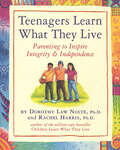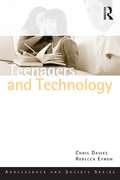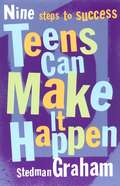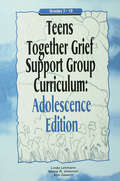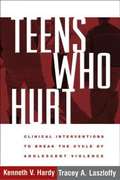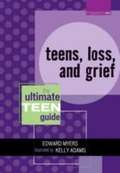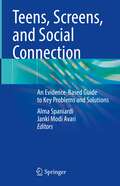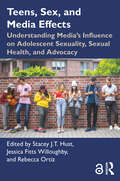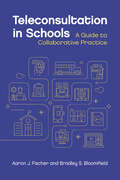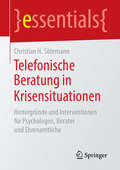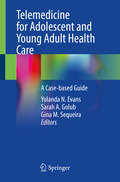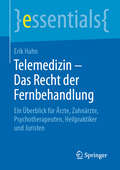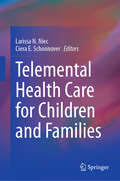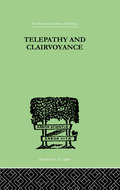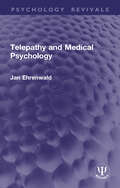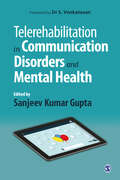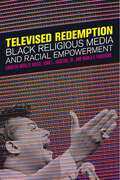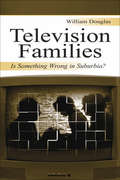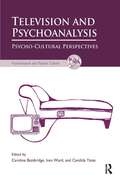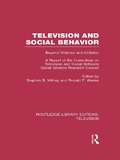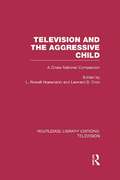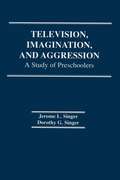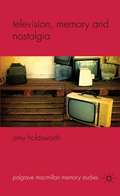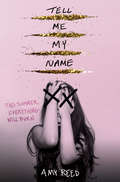- Table View
- List View
Teenagers Learn What They Live: Parenting To Inspire Integrity And Independence
by Rachel Harris Dorothy Law NolteParenting by example. Using the simple, powerful message that turned Children Learn What They Live into an international bestseller with over 1.5 million copies in print, Drs. Dorothy Law Nolte and Rachel Harris bring their unique perspective to families with adolescents. <P><P> Structured, like the first book, around an inspirational poem, Teenagers Learn What They Live addresses the turbulent teenage years, when a stew of hormones, pressures, and temptations makes for such extreme challenges for parents and children. Teenagers addresses popularity and peer pressure ("If teenagers live with rejection, they learn to feel lost"); the responsibilities of maturity ("If teenagers live with too many rules, they learn how to get around them./ If teenagers live with too few rules, they learn to ignore the needs of others"); body image and the allure of cigarettes, drugs, and alcohol ("If teenagers live with healthy habits, they learn to be kind to their bodies"). <P> Central to the book are ways for parents to communicate with their teenage children-including how to deal with being "tuned out" and when to start the conversation again-and how to strike the right balance between holding on and accepting a teen's growing independence. Hundreds of examples of parent-child interactions cover everything from the all-night graduation party to problems of sexual identity, providing great guidance as well as effective conversation starters.
Teenagers and Technology (Adolescence and Society)
by Chris Davies Rebecca EynonThe popular media often presents a negative picture of young people and technology. From addiction to gaming, the distractions of the Internet, to the risks of social networking, the downsides of new technology in the lives of teenagers are often over-blown. Teenagers and Technology presents a balanced picture of the part played by technology in the lives of young people. Drawing on extensive interviews conducted over several years, this book offers a timely and non-sensational exploration of teenagers’ experiences and opinions about the digital technologies they use, desire and dislike. The book covers a range of topical subjects including: Social networking and online engagement in the wider social world Building online self-identity and group membership Technology in the home Developing technology skills in support of learning Drawing on technological resources in the journey towards adulthood. Grounded in what young people actually say about using new technology in their daily lives, Teenagers and Technology presents a picture in which young people have in some respects a unique relationship to technology, but one that is actually not exceptional or of a completely different order to how people in general relate to it. By providing a nuanced view on the topic, Teenagers and Technology counters the extreme accounts of ‘digital youth’, and exaggerated anxieties created by the mass media. It will be of interest to students and academics working in the fields of adolescent and Internet studies, along with education professionals, practitioners, teenagers and their parents.
Teens Can Make It Happen: Nine Steps to Success
by Stedman GrahamFrom the prominent businessman and author of "You Can Make It Happen" comes a new personal success guide aimed at the booming teen audience. With refreshing honesty, Graham relates stories from his own experience and stresses the importance of self-esteem as the way to overcome peer pressure and daily stresses.
Teens Together Grief Support Group Curriculum: Adolescence Edition: Grades 7-12
by Shane R. Jimerson Linda Lehmann Ann GaaschThe texts focus on preschool-aged children, children in kindergarten through grade two, children in grades three through six, and teenagers.Each curriculum contains ten ninety-minute sessions that should be implemented over a period of ten weeks. By employing age-appropriate themes to engage the child and provide continuity throughout the sessions, the division of material within the curricula assures that the activities reflect the developmental level of the grieving child or adolescent. Each person grieves differently, and Grief Support Group Curriculum addresses the issues related to mourning while recognizing the importance of individuality in grieving.
Teens Who Hurt
by Tracey A. Laszloffy Kenneth V. HardyOffering a fresh perspective on treatment, this book presents an overarching framework and many specific strategies for working with violent youth and their families. The authors shed light on the complex interplay of individual, family, community, and societal forces that lead some adolescents to hurt others or themselves. Effective ways to address each of these factors in clinical and school settings are discussed and illustrated with evocative case material. The book provides essential guidance on connecting with aggressive teens and their parents and managing difficult situations that are likely to arise. The strengths-based interventions presented are applicable to a broad range of high-risk behaviors, from bullying and assault to substance abuse, self-mutilation, and suicidality.
Teens with Diabetes
by Michael A. Harris Korey K. Hood Jill Weissberg-BenchellWritten by three psychologists with more than 50 years of collective experience in the field of diabetes and youth, Teens with Diabetes provides evidence-based techniques for clinicians to treat the psychological needs of children with diabetes and help them transition into their teenage years. The authors have provided care to thousands of diabetic teens and their families from initial diagnosis to leaving home for college. Any professional working with diabetic teens, including psychologists, physicians, social workers, dietitians, and nurse educators, needs this how-to handbook for working with what is arguably one of the most difficult populations in diabetes. Topics covered include handling the initial diagnosis of diabetes in teens, talking with young people about diabetes in a manner that is effective and reduces reactivity, improving diabetes self-care, helping families negotiate the challenges of adolescent diabetes, dealing with peer relations, dealing with high-risk issues related to diabetes, and handling with mood problems.
Teens, Loss, and Grief: The Ultimate Teen Guide
by Edward MyersA self-help guide for adolescents coping with bereavement, this volume provides an overview of the grieving process. It also offers insights from bereavement experts and first-hand accounts from teens. Chapters address topics such as the nature of grief, the kinds of loss, effects of grief and loss, and warning signs. Annotation ©2004 Book News, Inc., Portland, OR (booknews.com)
Teens, Screens, and Social Connection: An Evidence-Based Guide to Key Problems and Solutions
by Alma Spaniardi Janki Modi AvariThis book explores the increasingly important intersection of the digital world and mental health in the lives of pediatric and young adult populations. Young people are spending a considerable amount of time on digital screen activities such as social media, texting, and online gaming. The vast majority of teens and pre-teens have access to computers and smartphones shifting social interaction away from face-to-face contact toward online communication. A practical resource, Teens, Screens, and Social Connection provides the reader with a targeted yet comprehensive understanding of a wide variety of internet and media-related topics facing youth today. Chapters include discussions on the developmental view from early childhood to young adulthood as well as the unique racial and cultural issues pertaining to technology and media. The book provides both the challenges of the internet and media to be identified as well as solutions and clinical pearls that can be immediately applied to clinical practice and real-world scenarios. This book is a practical reference that functions as a concise yet comprehensive summary of the most important aspects of this very timely and important topic. It is an invaluable, practical resource for mental health clinicians, as well as students and those professionals who work with youth in other domains.
Teens, Sex, and Media Effects: Understanding Media’s Influence on Adolescent Sexuality, Sexual Health, and Advocacy
by Stacey J.T. Hust Jessica Fitts Willoughby Rebecca OrtizWith teens having more control and choice over their media consumption than ever before, this book highlights how the current media landscape impacts adolescent sexuality in the areas of identity development, romantic and sexual relationships, sexual health, and advocacy and education.Recognizing that teens are often media multitaskers and media effects do not occur in isolation by platform, the book includes examinations of a wide variety of media types and content to provide a more comprehensive look at the media landscape and its impact on teen sexuality. While the text includes empirical, data-driven chapters that are authored by experts in the field, it also prioritizes the diverse voices of teens throughout. All research studies featured in the book are informed by data collection with teens themselves from various parts of the world representing a range of teen identities.This is a key text for researchers and undergraduate and graduate students in the fields of communication (including media effects and health communication); human development; psychology; and public health, with relevance to parents, educators, and policy makers as well.The Open Access version of this book, available at http://www.taylorfrancis.com, has been made available under a Creative Commons Attribution-Non Commercial-No Derivatives (CC BY-NC-ND) 4.0 license.
Teleconsultation in Schools: A Guide to Collaborative Practice (Applying Psychology in the Schools Series)
by Aaron J. Fischer PhD Bradley S. BloomfieldThis practical guide to teleconsulting for school psychology professionals demonstrates how rapid advances in the field can help them expand support for educators, administrators, students, and their families by providing online access to consulting services. As schools adapt to teaching in the era of COVID and beyond, educators and school administrators have an increased need for consultation services via videoconferencing and other technologies. This book provides the first comprehensive introduction to how school psychology professionals can provide effective and culturally-sensitive teleconsultation. The authors describe a step-by-step consulting framework for building productive and collaborative relationships with educators, students, and families, and for troubleshooting any technical or client-related difficulties that arise. This framework includes building rapport with clients, identifying the presenting problem, developing and implementing treatment plans, and performing ongoing evaluations. Case examples illustrate each chapter, and a variety of online infographics are available as learning aids. The book concludes with a consideration of barriers to service, including accessibility, and considers the future promise of teleconsultation in schools.
Telefonische Beratung in Krisensituationen
by Christian H. SötemannDieses essential bietet wichtige Hintergründe und Informationen, wie Psychologen, Berater und Ehrenamtliche am Telefon konstruktiv beraten können. Ressourcen- und lösungsorientierte Haltungen und Fragemöglichkeiten werden dabei ebenso behandelt wie der Umgang mit stark belasteten, oft traumatisierten Anrufenden. Für alle am Telefon Beratenden im psychosozialen Bereich werden wertvolle Hinweise gegeben, die sowohl der Vertiefung bestehender Kenntnisse als auch als Einführung in diese besondere Art der psychosozialen Beratung dienen.
Telemedicine for Adolescent and Young Adult Health Care: A Case-based Guide
by Yolanda N. Evans Sarah A. Golub Gina M. SequeiraWhile there are general texts on telemedicine and guidelines on the use of telemedicine in pediatrics, there are no texts focused specifically on the provision of health care to adolescents and young adults using telemedicine. Adolescents and young adults have more unique health care needs than both adults and children, including the need to receive developmentally appropriate services and care that may be provided in settings outside of the standard clinical office (such as school-based care). In addition, in most US states, adolescents are capable of providing consent for some but not all medical care, highlighting the critical importance of providing services in a manner that adheres to regulations around consent and confidentiality. Telemedicine for Adolescent and Young Adult Health Care offers readers case-based content written by experts in the fields of adolescent medicine and telemedicine. There are a variety of chapters that include anemphasis on equity, diversity, and inclusion and will include local and federal rules, regulations, and considerations for ensuring privacy in the modern electronic health record. The first chapter offers a general overview and history of telemedicine. The next one focuses on telemedicine and epidemics. The chapters in the middle detail a variety of topics related to telemedicine such as confidentiality, equity, telemedicine and learners, school-based care, telemedicine in primary care and ambulatory consultative care. The book closes out by emphasizing additional populations such as youth involved in the juvenile carcel system, homeless/housing insecure, foster involved youth and youth with developmental delay. It is a valuable resource for adolescent medicine specialists, pediatricians, primary care physicians and any other professional who treats the adolescent population.
Telemedizin – Das Recht der Fernbehandlung: Ein Überblick für Ärzte, Zahnärzte, Psychotherapeuten, Heilpraktiker und Juristen (essentials)
by Erik HahnDieses essential zeigt praxisnah die rechtlichen Anforderungen an eine (ausschließliche) Fernbehandlung aus deutscher Perspektive. Die berufs-, vertrags-, vergütungs-, werbe- und arzneimittelrechtlichen Grundlagen sowie die jeweiligen Besonderheiten für Ärzte, Zahnärzte, Psychotherapeuten und Heilpraktiker werden umfassend erläutert. Es bietet zudem einen Überblick über die europarechtlichen Vorgaben und deren Umsetzung im nationalen Recht. Außerdem wird das unterschiedlich ausgestaltete Fernbehandlungsrecht der einzelnen Heilberufskammern dargestellt.
Telemental Health Care for Children and Families
by Larissa N. Niec Ciera E. SchoonoverThis book examines state-of-the-science telemental health interventions for children and families. It explores the adaptations necessary to provide remote formats of evidence-based models, such as parent-child interaction therapy and trauma-focused cognitive behavior therapy. Chapters provide clear descriptions of how to implement interventions in a telemental health format, a review and critique of the empirical evidence supporting them, and useful case studies. The volume addresses the use of telemental health care within parenting interventions, individual child interventions, and family interventions, with particular attention paid to the evidence base of efficacy for families from marginalized and underserved communities. Key topics covered include: Remote assessment of child cognitive functioning Parent-child interaction therapy (PCIT). Trauma-focused cognitive behavioral therapy (TF-CBT). Mom Power, for mothers with histories of substance use or trauma. Applied behavioral analysis for children with autism spectrum disorder (ASD). Cognitive behavioral therapy for children with anxiety. Telemental health with LGBTQ+ youth Telemental Health Care for Children and Families is an essential resource for clinicians, therapists, and all mental health professionals as well as researchers, professors, and graduate students across many interrelated disciplines, including developmental, clinical child, and school psychology, family studies, social work, child and adolescent psychiatry, psychotherapy, and pediatrics.
Telepathy and Clairvoyance (International Library Of Psychology Ser.)
by Tischner, RudolfFirst published in 1999. Routledge is an imprint of Taylor & Francis, an informa company.
Telepathy and Medical Psychology (Psychology Revivals)
by Jan EhrenwaldFirst published in 1947, the original blurb for Telepathy and Medical Psychology reads: ‘An increasing mass of evidence compiled during the past years has made the occurrence of telepathy and related phenomena an established fact. However, contemporary medical psychology has refused so far to acknowledge their existence and to reconcile them with their systems of thought. Dr Ehrenwald’s book is the first serious attempt in this direction. He shows that telepathy is subject to much the same psychological laws as govern dreams, neurotic symptoms and certain manifestations of mental disease. His approach moves largely along the lines of the psychoanalyst, but his conclusions are likely to shake some of the basic propositions of psychoanalysis itself. At the same time they throw fresh light on certain aberrations of character and personality and his new interpretation of paranoia and related disorders may well mark a turning point in modern psychopathology and psychiatry.Dr Ehrenwald writes his book not only for the medical psychologist: the problems discussed called for the attention of a wider public and his way of presentation makes it fascinating reading for the educated layman.’ Today it can be read in its historical context.
Telerehabilitation in Communication Disorders and Mental Health
by Sanjeev Kumar GuptaThe increasing influence of digital media on all aspects of life, especially the use of Internet and smartphone, has not left even the field of healthcare practice untouched. Telerehabilitation, implying the use of telecommunications in rehabilitation activities, is being used widely in the treatment of communication and mental health disorders. The use of telerehabilitation services makes rehabilitation more feasible, fast, time-saving and cost-effective for people who face constraints in physically presenting themselves to healthcare providers due to extent of retardation, illness or commuting issues. It is thus a boon for the people who stay in remote areas and have no access to healthcare professionals in close vicinity. Therefore, research is underway on the optimal means to deliver telerehabilitation services both locally and globally and is now seen as a critical activity in healthcare.
Televised Redemption: Black Religious Media and Racial Empowerment
by Carolyn Moxley Rouse John L. Jackson Jr. Marla F. FrederickHow Black Christians, Muslims, and Jews have used media to prove their equality, not only in the eyes of God but in society. The institutional structures of white supremacy—slavery, Jim Crow laws, convict leasing, and mass incarceration—require a commonsense belief that black people lack the moral and intellectual capacities of white people. It is through this lens of belief that racial exclusions have been justified and reproduced in the United States. Televised Redemption argues that African American religious media has long played a key role in humanizing the race by unabashedly claiming that blacks are endowed by God with the same gifts of goodness and reason as whites—if not more, thereby legitimizing black Americans’ rights to citizenship. If racism is a form of perception, then religious media has not only altered how others perceive blacks, but has also altered how blacks perceive themselves. Televised Redemption argues that black religious media has provided black Americans with new conceptual and practical tools for how to be in the world, and changed how black people are made intelligible and recognizable as moral citizens. In order to make these claims to black racial equality, this media has encouraged dispositional changes in adherents that were at times empowering and at other times repressive. From Christian televangelism to Muslim periodicals to Hebrew Israelite radio, Televised Redemption explores the complicated but critical redemptive history of African American religious media.
Television Families: Is Something Wrong in Suburbia? (Routledge Communication Series)
by William DouglasThis volume examines the analysis that was designed to map the development of the television family and assess its current state and, at the same time, to provide insight into the tangled relationships between fictional and real family life. In order to do this, the investigation examines the evolution of the American family, paying special attention to the postwar family, which is not only used recurrently as a benchmark for assessing the performance of modern families but also constituted television's first generation of families. The investigation also traces the evolution of the popular family in vaudeville, comics, and radio. However, the primary focus of the examination is the development of the television family, from families, such as the Nelsons, Andersons, and Cleavers, to more contemporary families, such as the Huxtables, Conners, and Taylors. The unit of analysis for the investigation is the relationship rather than the individual. Hence, the book deals with the portrayal of spousal, parent-child, and sibling relationships and how those portrayals differ across time and across groups defined by ethnicity, gender, and age. Moreover, the relational analysis is expansive so that television family relationships are examined in regard to power and affect, performance, and satisfaction and stability. Television Families provides a thorough summary and critical review of extant research, designed to promote informed classroom discussion. At the same time, it advances a number of hypotheses and recommendations and, as such, is intended to influence subsequent theory and research in the area. The book is intended for senior undergraduate students, graduate students, and television and family researchers.
Television and Psychoanalysis: Psycho-Cultural Perspectives (The\psychoanalysis And Popular Culture Ser.)
by Ivan Ward Caroline Bainbridge Candida YatesDespite the prominence of television in our everyday lives, psychoanalytic approaches to its significance and function are notoriously few and far between. This volume takes up perspectives from object relations theory and other psychoanalytic approaches to ask questions about the role of television as an object of the internal worlds of its viewers, and also addresses itself to a range of specific television programmes, ranging from Play School, through the plays of Jack Rosenthal to recent TV blockbuster series such as In Treatment. In addition, it considers the potential of television to open up new public spaces of therapeutic experience. Interviews with a TV producer and with the subject of a documentary expressly suggest that there is scope for television to make a positive therapeutic intervention in people's lives. At the same time, however, the pitfalls of reality programming are explored with reference to the politics of entertainment and the televisual values that heighten the drama of representation rather than emphasising the emotional experience of reality television participants and viewers.
Television and Social Behavior: Beyond Violence and Children / A Report of the Committee on Television and Social Behavior, Social Science Research Council (Routledge Library Editions: Television)
by Stephen B. Withey and Ronald P. AbelesThis book, published originally in 1980, addressed the needs for a profile of televised violence which considered the advantages and disadvantages of various measures and for a furthering of research directions beyond the then-popular emphasis on children. The Committee on Television and Social Behavior was formed in1972 and stimulated new research in order to provide a multidimensional profile of the social effects of television programming. Chapters here look at the effect of television on adults as well as children, particularly special audiences such as the elderly and minority groups. An excellent summary of the various conceptual, substantive and methodological issues around television’s influence.
Television and the Aggressive Child: A Cross-national Comparison (Routledge Library Editions: Television)
by L. Rowell Huesmann and Leonard D. EronThe research presented in this book, originally published in 1986, looks to pinpoint the psychological processes involved in the media violence-aggression relation. Expanding on earlier studies, the compilation of essays here delves deeply into aggression study and compares results about media influence across 5 countries. Cultural norms and programming differences are investigated as well as age and gender and other factors. What is offered overall is a psychological model in which TV violence is both a precursor and a consequence of aggression.
Television, Imagination, and Aggression: A Study of Preschoolers
by D. G. SingerFirst Published in 1981. Routledge is an imprint of Taylor & Francis, an informa company.
Television, Memory and Nostalgia
by Amy HoldsworthAn innovative and original new study, Television, Memory and Nostalgia re-imagines the relationship between the medium and its forms of memory and remembrance through a series of case studies of British and North American programmes and practices. These include ER , Grey's Anatomy , The Wire , Who Do You Think You Are? , and Life on Mars .
Tell Me My Name
by Amy ReedWe Were Liars meets Speak in this haunting, mesmerizing psychological thriller—a gender-flipped YA Great Gatsby—that will linger long after the final lineOn wealthy Commodore Island, Fern is watching and waiting—for summer, for college, for her childhood best friend to decide he loves her. Then Ivy Avila lands on the island like a falling star. When Ivy shines on her, Fern feels seen. When they're together, Fern has purpose. She glimpses the secrets Ivy hides behind her fame, her fortune, the lavish parties she throws at her great glass house, and understands that Ivy hurts in ways Fern can't fathom. And soon, it's clear Ivy wants someone Fern can help her get. But as the two pull closer, Fern's cozy life on Commodore unravels: drought descends, fires burn, and a reckless night spins out of control. Everything Fern thought she understood—about her home, herself, the boy she loved, about Ivy Avila—twists and bends into something new. And Fern won't emerge the same person she was.An enthralling, mind-altering psychological thriller, Tell Me My Name is about the cost of being a girl in a world that takes so much, and the enormity of what is regained when we take it back.The New York Times: "13 Y.A. Books to Add to Your Reading List This Spring""A lush, gorgeously crafted page-turner." —Jennifer Mathieu, author of Moxie&“A kaleidoscope of light and shadow that will keep you flipping page after page.&” —Amber Smith, author of The Way We Used to Be ★ "Immersive [and] smartly written.&” —SLJ (starred review)&“Only Amy Reed could write a novel this dark, this gorgeous, this forward-looking while speaking to our present moment.&” —Wiley Cash, author of A Land More Kind Than Home"The best kind of literary thriller—one with as much conscience as pulse." —Brendan Kiely, co-author of All American Boys&“I haven&’t felt this way since reading We Were Liars—mind blown.&” —Jaye Robin Brown, author of Georgia Peaches and Other Forbidden Fruit★ "As much Hitchcockian suspense as Fitzgerald&’s tarnished glitz." —BCCB (starred review)"This novel is amazing . . . A pulsating, hypnotic retelling.&” —Lilliam Rivera, author of The Education of Margot Sanchez&“Relentlessly compelling . . . Reed's latest is a literary thrill ride.&” —Kelly Jensen, author of (Don&’t) Call Me Crazy and editor at BookRiot&“[A] harrowing tale of personal trauma in a violently polarized society.&” —Kirkus&“A compelling and propulsive thriller.&” —Jeff Zentner, author of The Serpent King"I barely breathed the last 100 pages. Simply stunning.&” —Megan Shepherd, author of The Madman's Daughter
